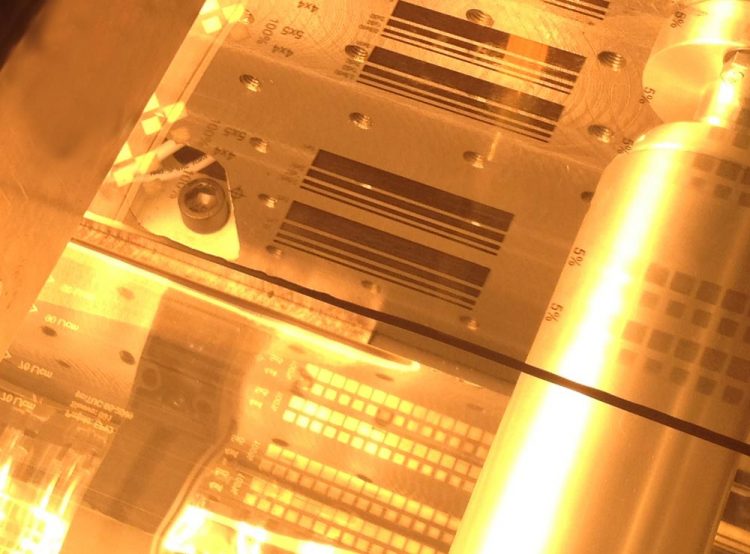Innovative Infrared System Dries and Sinters Printed Electronics Almost 2000 Times Faster than Previously

Infrared emitters dry and sinter within 0.32 seconds. Copyright Heraeus Noblelight 2016
The continuous printing of electronics for displays or solar cells, depends on a rapid drying of the surface and good conductivity of the silver inks. A newly developed infrared module from Heraeus Noblelight achieves this in significantly less than one second (0.32 secs) and is consequently almost 2000 times faster than conventional drying techniques.
Heraeus developed and installed the made-to-measure module in a roll-to-roll printing system. In tests, the infrared radiation proved far superior to drying and sintering using conventional hot plates or hot air ovens. These trials were carried out in the Department of Digital Printing and Graphics Technology of Chemnitz Technical University and the Fraunhofer Institute for Electronic Nanosystems.
Heraeus will be presenting this exciting innovation, together with other UV, Infrared, and Flashlamp systems for the printed electronics sector at the Lopec exhibition in Munich in April 2016.
Metallic nano particles for printed electronics are often deposited onto flexible and polymeric materials using Inkjet printing and are then dried and sintered. On a laboratory scale, this is mostly achieved using hot plates or hot air. However, for mass production, the Roll-to-Roll (R2R) technique must be used. And this means that drying and sintering must be significantly faster.
New techniques have been investigated, such as microwaves, lasers, Intense Pulse Light (IPL) and infrared radiation. The optimum technique must be able to dry and sinter quickly and efficiently, while at the same time causing no damage to the polymer substrate, which is often temperature sensitive.
Heraeus has developed a purpose-built infrared module for an R2R printing system. This has been used to carry out tests on the infrared drying and sintering of inkjet printed silver coatings on polyethylene naphtalate. (PEN). It could be shown that the post treatment of the freshly printed deposit led to a conductivity of up to 15% of pure silver.
Compared with drying and sintering with conventional hot plates or hot air, infrared radiation achieved twice the conductivity in only 0.32 seconds. In contrast, using a hot plate, drying and sintering took about ten minutes.
Using electron microscope imaging, the microstructure of the sintered silver particles was then analyzed in relation to the IR parameters (filament temperature of the emitter, duration and power of the radiation and distance of the emitter and reflector from the substrate.)
After optimizing these parameters, the silver was then dried at 50 kW/m2 and sintered at 150 kW/m2. Using the same short wave emitter each time, merely requiring control adjustment. The printed electronics on the continuous foil can therefore be dried and sintered in one stage, at high belt speeds of up to 1 m/sec and an irradiation time of less than 0.32 seconds.
This research and development work was recently published in the Journal Materials Chemistry C: E. Sowade, H. Kang, K.Y. Mitra, O.J. Weiß, J. Weber, R.R. Baumann, Roll-to-roll infrared (IR) drying and sintering of an inkjet-printed silver nanoparticle ink within 1 second, J. Mater. Chem. C. 3 (2015) 11815–11826. doi:10.1039/C5TC02291F.
Heraeus, the technology group headquartered in Hanau, Germany, is a leading international family-owned company formed in 1851. With expertise, a focus on innovations, operational excellence and an entrepreneurial leadership, we strive to continuously improve our business performance.
We create high-quality solutions for our clients and strengthen their competitiveness in the long term by combining material expertise with technological know-how. Our ideas are focused on themes such as the environment, energy, health, mobility and industrial applications. Our portfolio ranges from components to coordinated material systems which are used in a wide variety of industries, including the steel, electronics, chemical, automotive and telecommunications industries.
In the 2014 financial year, Heraeus generated product revenues of €3.4 bn and precious metal revenues of €12.2bn euros. With around 12,600 employees worldwide in more than 100 subsidiaries in 38 countries, Heraeus holds a leading position in its global markets.
Heraeus Noblelight GmbH with its headquarters in Hanau and with subsidiaries in the USA, Great Britain, France, China and Australia, is one of the technology- and market-leaders in the production of specialist light sources and systems. In 2014, Heraeus Noblelight had an annual turnover of 137.3 Million € and employed 884 people worldwide. The organization develops, manufactures and markets infrared and ultraviolet emitters, systems and solutions for applications in industrial manufacture, environmental protection, medicine and cosmetics, research, development and analytical measurement techniques.
For further information, please contact:
Technical: Heraeus Noblelight GmbH
Reinhard-Heraeus-Ring 7
D-63801 Kleinostheim
Tel +49 6181/35-8545, Fax +49 6181/35-16 8545
E-Mail hng-infrared@heraeus.com
Press: Dr. Marie-Luise Bopp
Heraeus Noblelight GmbH,
Abteilung Marketing/Werbung
Tel +49 6181/35-8547, Fax +49 6181/35-16 8547
E-Mail marie-luise.bopp@heraeus.com
www.heraeus-noblelight.com
Media Contact
All latest news from the category: Trade Fair News
Newest articles

A ‘language’ for ML models to predict nanopore properties
A large number of 2D materials like graphene can have nanopores – small holes formed by missing atoms through which foreign substances can pass. The properties of these nanopores dictate many…

Clinically validated, wearable ultrasound patch
… for continuous blood pressure monitoring. A team of researchers at the University of California San Diego has developed a new and improved wearable ultrasound patch for continuous and noninvasive…

A new puzzle piece for string theory research
Dr. Ksenia Fedosova from the Cluster of Excellence Mathematics Münster, along with an international research team, has proven a conjecture in string theory that physicists had proposed regarding certain equations….



